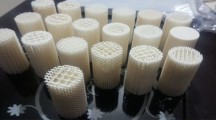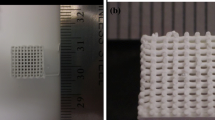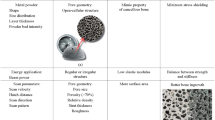Abstract
Due to the advent and maturity of the additive manufacturing technology, it is possible now to construct complex microstructures with unprecedented accuracy. In addition, to the influence of network unit cell types and porosities in recent years, researchers have studied the number of scaffold layers fabricated by additive manufacturing on mechanical properties. The objective of this paper is to assess the numerical and analytical simulations of the multilayer scaffolds. For this purpose, 54 different regular scaffolds with a unit cell composed of multilayer scaffolds were simulated under compressive loading and compared with the analytical relationships based on the Euler–Bernoulli and Timoshenko's beam theories where the most appropriate theory was chosen for different unit cell sizes. Then, five types of two- and three-layer scaffolds of titanium alloy were simulated based on the previous data numerically and analytically, and the young's modulus and yield strength of the scaffolds were compared with the experimental results, where a good convergence between the results of the finite element model and previous experimental results were observed. Furthermore, the axial forces of the unit cell struts, in the transverse section, stress distribution, and displacement of the nodes in the scaffolds, were investigated, which was not possible experimentally.















Similar content being viewed by others
Abbreviations
- E :
-
Scaffold young modulus (GPa)
- E s :
-
Material young modulus (GPa)
- l :
-
Length unit cell
- r :
-
Radial of cell strut
- ρ :
-
Apparent density
- σ y :
-
Scaffold yield strength (MPa)
- σ ys :
-
Material yield strength (MPa)
- ν s :
-
Material Poisson's ratio
- i :
-
Layer number
- s:
-
Scaffolding material
- t:
-
Total scaffold
References
Wang X, Xu S, Zhou S, Xu W, Leary M, Choong P, Qian M, Brandt M, Xie YM (2016) Topological design and additive manufacturing of porous metals for bone scaffolds and orthopaedic implants: a review. Biomaterials 83:127–141
Surmeneva M, Surmenev R, Chudinova E, Koptioug A, Tkachev M, LE Gorodzha R (2017) Fabrication of multiple-layered gradient cellular metal scaffold via electron beam melting for segmental bone reconstruction. Mater Des 133:195–204
Tampieri A, Celotti G, Sprio S, Delcogliano A, Franzese S (2001) Porosity-graded hydroxyapatite ceramics to replace natural bone. Biomaterials 22:1365–1370
Pompe W, Worch H, Epple M, Friess W, Gelinsky M, Greil P, Hempel U, Scharnweber D, Schulte K (2003) Functionally graded materials for biomedical applications. Mater Sci Eng A 362:40–60
Becker B, Bolton J (1997) Corrosion behaviour and mechanical properties of functionally gradient materials developed for possible hard-tissue applications. J Mater Sci Mater M 8:793–797
Qia W, Qig W, Wan C (2012) Preparation and evaluation of a biomimetic scaffold with porosity gradients in vitro. An Braz Acad Sci 84:9–16
Kwok PJ, Oppenheimer SM, Dunand DC (2008) Porous titanium by electro-chemical dissolution of steel space-holders. Adv Eng Mater 10:820–825
Heinl P, Müller L, Körner C, Singer RF, Müller FA (2008) Cellular Ti-6Al-4Vstructures with interconnected macro porosity for bone implants fabricated by selective electron beam melting. Acta Biomater 4:1536–2154
Mullen L, Stamp RC, Brooks WK, Jones E, Sutcliffe CJ (2009) Selective laser melting: a regular unit cell approach for the manufacture of porous, titanium, bone in-growth constructs, suitable for orthopedic applications. J Biomed Mater Res B Appl Biomater 89:325–334
Campoli G, Borleffs M, Amin Yavari S, Wauthle R, Weinans H, Zadpoor AA (2013) Mechanical properties of open-cell metallic biomaterials manufactured using additive manufacturing. Mater Des 49:957–965
Gibson LJ, Ashby MF (1997) Cellular Solids: Structure and Properties, Cambridge University Press
Luxner MH, Woesz A, Stampfl J, Fratzl P, Pettermann HE (2009) A finite element study on the effects of disorder in cellular structures. Acta Biomater 5:381–390
Parthasarathy J, Starly B, Raman S, Christensen A (2010) Mechanical evaluation of porous titanium (Ti6Al4V) structures with electron beam melting (EBM). J Mech Behav Biomed Mater 3:249–259
Hedayati R, Sadighi M, Mohammadi-Aghdam M, Zadpoor AA (2016) Mechanical properties of regular porous biomaterials made from truncated cube repeating unit cells: analytical solutions and computational models. Mater Sci Eng C 60:163–183
Babaee S, Jahromi BH, Ajdari A, Nayeb-Hashemi H, Vaziri A (2012) Mechanical properties of open-cell rhombic dodecahedron cellular structures. Acta Mater 60:2873–2885
Borleffs M (2012) Finite element modeling to predict bulk mechanical properties of 3D printed metal foams. Delft University of Technology, TU Delft, Delft
Hedayati R, Sadighi M, Mohammadi-Aghdam M, Zadpoor AA (2016) Mechanical behavior of additively manufactured porous biomaterials made from truncated cuboctahedron unit cells. Int J Mech Sci 106:19–38
Shulmeister V, Van der Burg M, Van der Giessen E, Marissen R (1988) A numerical study of large deformations of low-density elastomeric open-cell foams. Mech Mater 30:125–140
Warren W, Kraynik A (1997) Linear elastic behavior of a low-density Kelvin foam with open cells. J Appl Mech 64:787–794
Zheng X, Lee H, Weisgraber TH, Shusteff M, DeOtte J, Duoss EB, Kuntz JD, Biener MM, Ge Q, Jackson JA (2014) Ultralight, ultrastiff mechanical metamaterials. Science 344:1373–1377
Hedayati R, Sadighi M, Mohammadi-Aghdam M, Zadpoor AA (2016) Mechanics ofadditively manufactured porous biomaterials based on the rhombicuboctahedron unit cell. J Mech Behav Biomed Mater 53:272–294
Ptochos E, Labeas G (2012) Elastic modulus and Poisson’s ratio determination of microlattice cellular structures by analytical, numerical and homogenisation methods. J Sandwich Struct Mater 14:597–626
Ptochos E, Labeas G (2012) Shear modulus determination of cuboid metallic open-lattice cellular structures by analytical, numerical and homogenisation methods. J Strain 48:415–429
Ahmadi S, Campoli G, Amin Yavari S, Sajadi B, Wauthl´eSchrootenWeinansZadpoor RJHAA (2014) Mechanical behavior of regular open-cell porous biomaterials made of diamond lattice unit cells. J Mech Behav Biomed Mater 34:106–115
Hedayati R, Sadighi M, Mohammadi-Aghdam M, Zadpoor AA (2016) Effect of massmultiple counting on the elastic properties of open-cell regular porous biomaterials. Mater Des 89:9–20
Bitsche R, Daxner T, B¨ohm HJ (2005) Space-filling polyhedra as mechanical models for solidified dry foams. Technische Universit¨at Wien
Buffel B, Desplentere F, Bracke K, Verpoest I (2014) Modelling open cell-foams based on the Weaire–Phelan unit cell with a minimal surface energy approach. Int J Solids Struct 51:3461–3470
Kraynik AM, Reinelt DA (1996) Linear elastic behavior of dry soap foams. J Colloid Interface Sci 181:511–520
Laurencin CT, Khan Y, Ma PX, Elisseeff J (2006) Polymer/calcium phosphate scaffolds for bone tissue engineering. In: Ma PX, Elisseeff J (eds) Scaffolding in tissue engineering, pp 253–265
Zadpoor A, Hedayati R (2016) Analytical relationships for prediction of the mechanical properties of additively manufactured porous biomaterials. J Biomed Mater Res Part A 104(12):3164–3174
Ushijima K, Cantwell WJ, Mines RAW, Tsopanos S, Smith M (2010) An investigation into the compressive properties of stainless steel micro-lattice structures. J Sandwich Struct Mater 13:303–329
Daxner T (2010) Finite element modeling of cellular materials, cellular and porous materials in structures and processes. Springer, Berlin, pp 47–106
Tan XP, Tan YJ, Chow CSL, Tor SB, Yeong WY (2017) Metallic powder-bed based 3D printing of cellular scaffolds for orthopaedic implants: a state-of-the-art review on manufacturing, topological design, mechanical properties and biocompatibility. Mater Sci Eng C 76:1328–1343
Choi K, Kuhn JL, Ciarelli MJ, Goldstein SA (1990) The elastic moduli of human subchondral, trabecular, and cortical bone tissue and the size-dependency of cortical bone modulus. J Biomech 23:1103–1113
Rho JY, Kuhn-Spearing L, Zioupos P (1998) Mechanical properties and the hierarchical structure of bone. Med Eng Phys 20:92–102
Rho JY, Ashman RB, Turner CH (1993) Young's modulus of trabecular and cortical bone material: ultrasonic and microtensile measurements. J Biomech 26:111–119
Bayraktar HH, Morgan EF, Niebur GL, Morris GE, Wong EK, Keaveny TM (2004) Comparison of the elastic and yield properties of human femoral trabecular and cortical bone tissue. J Biomech 37:27–35
Yavari SA, Wauthlé R, van der Stok J, Riemslag AC, Janssen M, Mulier M, Kruth JP, Schrooten J, Weinans H, Zadpoor AA (2013) Fatigue behavior of porous biomaterials manufactured using selective laser melting. Mater Sci Eng C 33:4849–4858
Song HW, He QJ, Xie JJ, Tobota A (2008) Fracture mechanisms and size effects of brittle metallic foams: in situ compression tests inside SEM. Compos Sci Technol 68:2441–2450
Li S, Zhao S, Hou W, Teng C, Hao Y, Li Y, Yang R, Misra RDK (2016) Functionally graded Ti6Al4V meshes with high strength and energy absorption. Adv Eng Mater 18:34–38
Wieding J, Souffrant R, Mittelmeier W, Bader R (2013) Finite element analysis on the biomechanical stability of open porous titanium scaffolds for large segmental bone defects under physiological load conditions. Med Eng Phys 35:422–432
Author information
Authors and Affiliations
Corresponding author
Additional information
Technical Editor: Paulo de Tarso Rocha de Mendonça, Ph.D..
Publisher's Note
Springer Nature remains neutral with regard to jurisdictional claims in published maps and institutional affiliations.
Rights and permissions
About this article
Cite this article
Khanaki, H.R., Rahmati, S., Nikkhoo, M. et al. Numerical and analytical simulation of multilayer cellular scaffolds. J Braz. Soc. Mech. Sci. Eng. 42, 268 (2020). https://doi.org/10.1007/s40430-020-02335-0
Received:
Accepted:
Published:
DOI: https://doi.org/10.1007/s40430-020-02335-0




